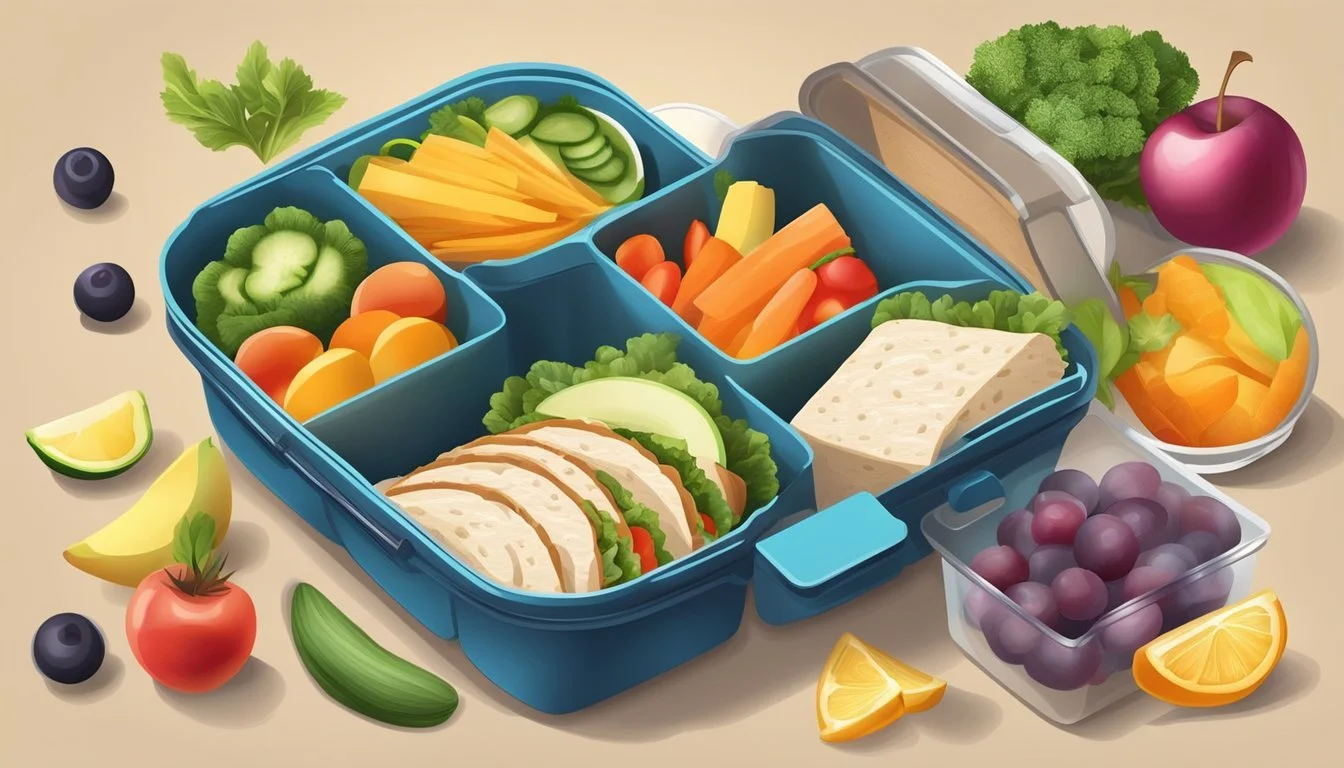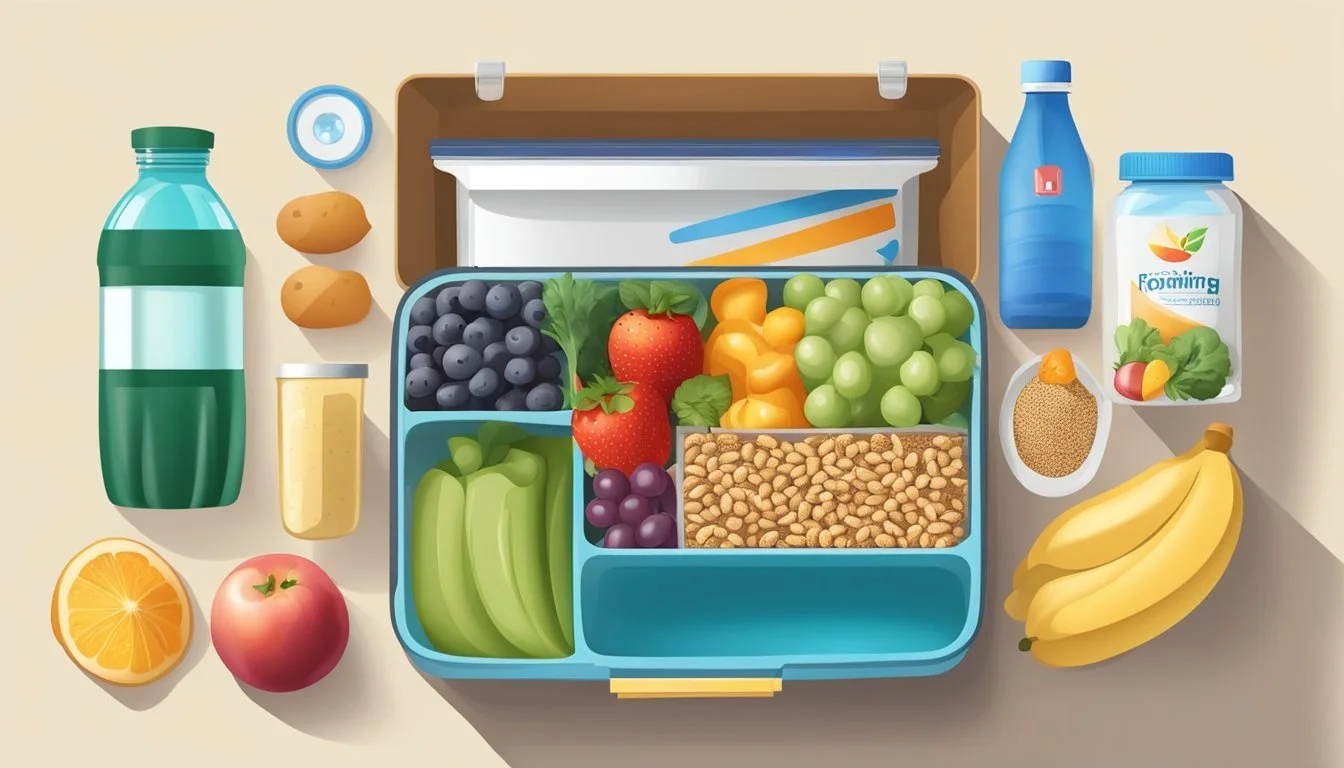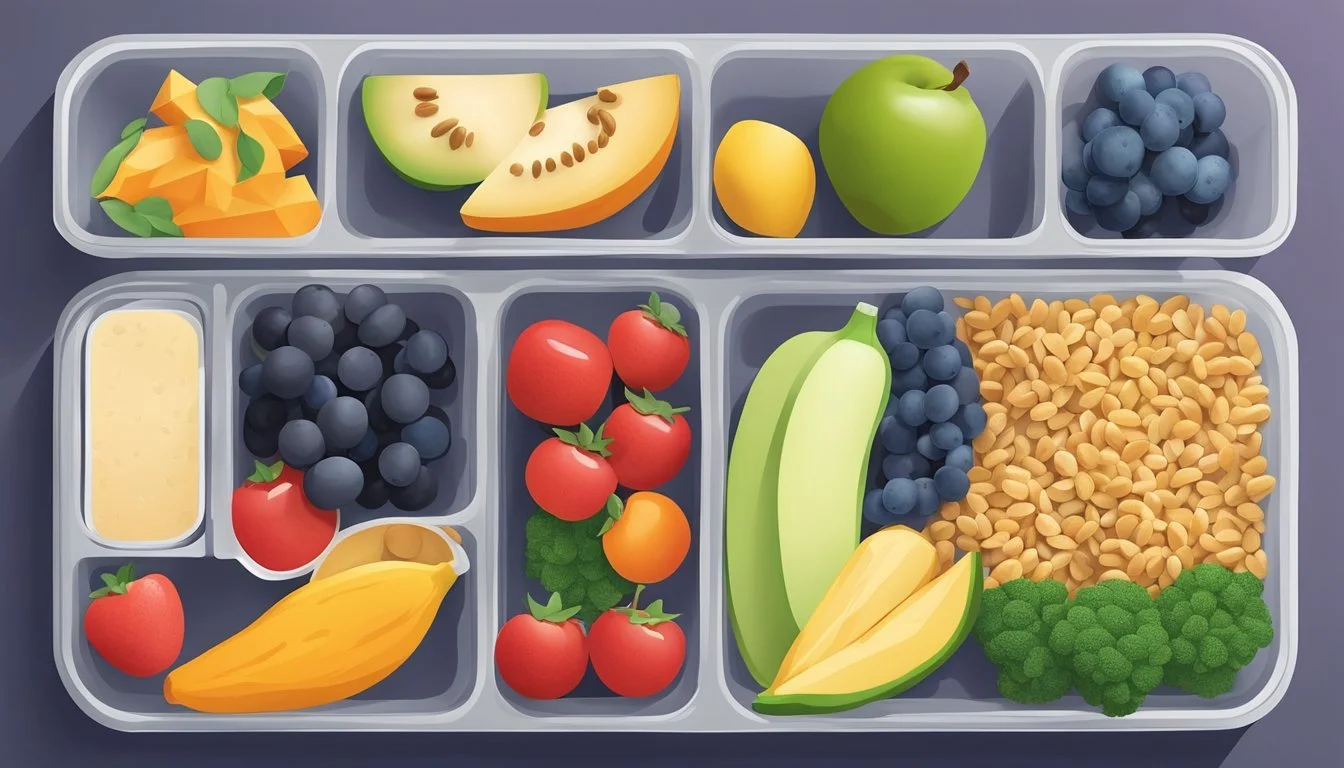10 Healthy Lunch Box Ideas for Diabetic Adults
Nutritious and Easy Options
Choosing the right lunch box ideas for diabetic adults can be crucial in managing blood sugar levels effectively. Healthy, balanced meals that are low in simple carbohydrates and high in nutrients not only help maintain energy throughout the day but also support overall health.
What are the best lunch options for adults with diabetes seeking to maintain stable blood sugar levels? This article provides ten practical and tasty lunch box ideas designed specifically for diabetic adults, helping to make meal planning easier and more enjoyable. Each suggestion focuses on a mix of proteins, healthy fats, and complex carbohydrates, ensuring a balanced and diabetes-friendly diet.
1) Grilled Chicken Salad with Quinoa
Grilled Chicken Salad with Quinoa offers a balanced and nutritious lunch option for diabetic adults. Combining lean protein from the grilled chicken with the nutrient-rich quinoa creates a satisfying dish.
The preparation involves grilling chicken breasts until they're cooked through. Then, cook quinoa according to package instructions, ensuring it is fluffy and light.
Toss the cooked quinoa in a bowl along with chopped vegetables like cherry tomatoes, cucumbers, and bell peppers. This mix provides a variety of vitamins and minerals.
Next, slice the grilled chicken into thin strips and add it to the quinoa and vegetables. A light olive oil and lemon dressing can enhance the flavors without adding unnecessary sugars.
This salad can be served fresh or stored in an airtight container for a convenient lunch. It’s a healthy, diabetes-friendly meal that is easy to prepare and transport.
2) Whole Grain Turkey Wrap
A whole grain turkey wrap offers a nutritious and satisfying option for diabetic adults. Whole grain tortillas provide complex carbohydrates, which help manage blood sugar levels more effectively than refined grains.
Turkey is an excellent source of lean protein. Adding turkey to the wrap supplies essential amino acids without unnecessary saturated fats, supporting muscle maintenance and overall health.
Layer the wrap with fresh vegetables like spinach, tomatoes, and cucumbers. These ingredients add fiber, vitamins, and minerals, enhancing the nutritional profile and aiding in digestion.
For added flavor and healthy fats, include avocado slices. Avocado complements the turkey and vegetables, offering a creamy texture without raising blood sugar levels.
A simple mustard or low-fat yogurt-based sauce can be used instead of high-calorie dressings. This ensures the wrap remains diabetes-friendly while still being delicious.
3) Greek Yogurt with Berries and Nuts
Greek yogurt with berries and nuts makes for a nutritious and delicious lunch box idea for diabetic adults. The Greek yogurt provides a good source of protein, which helps maintain stable blood sugar levels throughout the day.
Fresh berries such as strawberries, blueberries, and raspberries add natural sweetness without the need for added sugars. These berries are also packed with antioxidants and fiber, which are beneficial for overall health.
Nuts like almonds, walnuts, or pecans introduce healthy fats and add a satisfying crunch to the mix. These nuts also contain vitamins and minerals that support heart health.
To prepare, simply layer unsweetened Greek yogurt in a container, followed by a mix of fresh berries. Sprinkle a handful of nuts on top for added texture and flavor. This dish can be prepared ahead of time and stored in a sealed container for easy transport.
For added convenience, this combination can be pre-packaged in small jars, making it an easy grab-and-go option for busy days. This meal provides a balanced mix of protein, healthy fats, and fiber, making it suitable for those managing diabetes.
By combining these ingredients, diabetic adults can enjoy a satisfying and health-conscious lunch option. This meal is not only easy to prepare but also offers a delightful mix of flavors and textures.
4) Vegetable Stir-Fry with Brown Rice
A vegetable stir-fry with brown rice is a nutritious and delicious option for a diabetic-friendly lunch box. This meal is packed with fiber, vitamins, and minerals from various vegetables, making it a healthy choice.
To prepare, start by heating a small amount of olive oil or coconut oil in a wok or large sauté pan over medium heat. Add vegetables such as broccoli, bell peppers, onions, and mushrooms. Stir-fry for about 6 to 7 minutes until the vegetables are crisp-tender.
Next, introduce spinach and carrots to the pan and cook until the spinach is wilted, which usually takes about 3 minutes. For added flavor, a mixture of soy sauce, rice vinegar, vegetable broth, cornstarch, and a brown sugar blend can be whisked together and added to the pan. Stir until the sauce thickens.
Serve the vegetable stir-fry over a bed of brown rice. Brown rice is a better option compared to white rice due to its higher fiber content, which helps stabilize blood sugar levels. This dish not only provides essential nutrients but also offers a satisfying meal to keep energy levels steady.
5) Avocado and Tuna Salad
Avocado and tuna salad is an excellent choice for a healthy lunch box. It combines the heart-healthy fats from avocado with the high-quality protein from tuna, making it ideal for maintaining steady blood sugar levels.
Preparing this salad is quick and easy. Chop a medium avocado and mix it with a can of drained tuna. Add some store-bought pico de gallo or your favorite fresh salsa to enhance the flavors.
This salad can be seasoned with a pinch of salt and pepper. Adding a squeeze of lemon juice will give it a refreshing tang. For those who prefer a bit more crunch, diced celery or red onions can be mixed in.
Not only is this dish low in carbohydrates, but it also includes fiber and protein. These nutrients are important for those managing diabetes as they help to maintain energy levels throughout the day.
Packing this salad in an airtight container will keep it fresh until lunchtime. Consider pairing it with some whole-grain crackers or a small side of fresh fruit for a balanced meal. This salad is versatile, nutritious, and delicious, making it a perfect addition to any diabetic-friendly lunch box.
6) Cottage Cheese with Fresh Fruit
Cottage cheese provides a protein-packed option that is especially beneficial for diabetic adults. It has a low glycemic index and can help maintain stable blood sugar levels.
Pairing cottage cheese with fresh fruit adds natural sweetness and nutritional variety. Opt for fruits like berries, apples, and pears, which have moderate sugar content and are rich in fiber.
A sprinkle of cinnamon or a handful of nuts can add both flavor and texture. This combination enhances the meal without adding unhealthy elements.
To prepare, start with a serving of cottage cheese, and top it with a mix of cut fresh fruits. Ensure the portions are appropriate to keep the meal balanced and nutritious.
This lunch box idea is convenient and versatile, making it easy to adapt to different preferences and seasons.
7) Chickpea and Spinach Stew
Chickpea and spinach stew is a nutritious and satisfying dish perfect for diabetic adults looking for a hearty lunch option. This stew combines the protein and fiber-rich qualities of chickpeas with the nutrient-dense benefits of spinach.
To prepare, heat oil in a large pot over medium-high heat. Add turkey, oregano, fennel seeds, and crushed red pepper. Cook until the turkey is no longer pink.
Next, add chopped onions, carrots, and garlic. Stir until the vegetables become soft and fragrant. Toss in the chickpeas and fresh spinach leaves, allowing the spinach to wilt.
Pour in a low-sodium broth to keep the dish heart-friendly. Let the mix simmer until all ingredients are thoroughly cooked. Season with salt and pepper to taste.
This stew can be prepared in advance and stored in portions, making it a convenient option for meal prepping. Its balanced mix of protein, fiber, and greens makes it suitable for maintaining stable blood sugar levels. It is a tasty addition to any diabetic-friendly diet.
8) Baked Salmon with Asparagus
Baked Salmon with Asparagus is a nutritious and delicious lunch option. Salmon is rich in protein and omega-3 fatty acids, which are essential for heart health. Asparagus adds a variety of vitamins and minerals, making this a well-rounded meal.
Preheat the oven to 400°F. Place salmon fillets and trimmed asparagus on a baking sheet. Drizzle with a mixture of olive oil, lemon juice, and minced garlic for added flavor. Season with salt and pepper to taste.
Wrap the salmon and asparagus in aluminum foil or parchment paper. This prevents moisture loss and ensures even cooking. Bake for about 15-20 minutes or until the salmon is cooked through and flakes easily with a fork.
Including this dish in a diabetic-friendly diet provides a balanced intake of healthy fats, protein, and fiber. It's simple to prepare and can be a refreshing addition to a lunch box, keeping meals varied and interesting.
9) Lentil and Vegetable Soup
Lentil and vegetable soup is a nutritious and filling option perfect for diabetic adults. Lentils are high in fiber and protein, which help stabilize blood sugar levels.
This soup includes a mix of vegetables like carrots, celery, and onions. These vegetables add essential vitamins and minerals while keeping the dish low in calories.
Cooking the lentils and vegetables in a low-sodium vegetable broth enhances the flavor without adding unnecessary salt. Herbs like thyme and a bay leaf can be included for additional depth and aroma.
Including vegetables like red potatoes adds texture and heartiness to the soup without significantly raising blood sugar. A small amount of olive oil can be used for sautéing the vegetables, contributing healthy fats.
For added flavor, spices such as garlic and cumin are used. These ingredients not only enhance taste but also carry their own health benefits.
This simple and wholesome meal can be prepared in advance and stored in the refrigerator. It makes for a convenient, diabetic-friendly lunch option that can be easily packed into a lunch box.
10) Egg Salad with Whole Grain Crackers
Egg salad with whole grain crackers presents a delicious and diabetes-friendly lunch option. The mix of protein and complex carbohydrates helps maintain stable blood sugar levels.
Start by boiling eggs for about 8 minutes, then transfer them to an ice bath to cool. Peel and chop the eggs, and place them in a bowl.
Next, add light mayonnaise, Dijon mustard, diced celery, and red onion. Season with salt and black pepper. Mix well to ensure all ingredients are fully incorporated.
Serve the egg salad alongside whole grain crackers. The crackers provide a satisfying crunch and fiber, which aids in digestion and keeps you feeling full longer.
For added variety, consider including some fresh vegetables on the side, such as cucumber slices or cherry tomatoes. This combination offers a balanced and nutritious meal, ideal for those managing diabetes.
Understanding Diabetes and Diet
Diet plays a crucial role in managing diabetes. Key areas include making informed food choices and meeting specific nutritional needs tailored for diabetic health.
How Diabetes Affects Food Choices
Diabetes influences how the body processes glucose. People with diabetes must be mindful of carbohydrate intake since it impacts blood sugar levels. Complex carbs, such as whole grains and legumes, are preferred over refined sugars due to their slower digestion.
Fiber is essential as it aids in blood sugar control. Foods rich in fiber include vegetables, fruits, and whole grains. Diabetic individuals should also monitor portion sizes to avoid spikes in blood sugar.
Limiting saturated fats and sodium is important. High-fat foods can lead to weight gain and insulin resistance, further complicating diabetes management. Sodium control helps maintain healthy blood pressure, crucial for diabetic health.
Nutritional Needs of Diabetic Adults
Diabetic adults require a balanced diet to manage blood sugar effectively. Protein-rich foods help in maintaining muscle mass and providing steady energy. Examples include lean meats, fish, tofu, and legumes.
Healthy fats are another staple, found in nuts, seeds, avocados, and olive oil. These fats support heart health, particularly important for those with diabetes who are at higher risk of cardiovascular issues.
Vitamins and minerals such as magnesium and chromium can support glucose metabolism. A diet rich in green leafy vegetables, nuts, and seeds helps meet these requirements.
Hydration plays a vital role as water helps in maintaining proper glucose levels. Avoid sugary drinks and opt for water, herbal teas, or zero-calorie beverages.
Essential Components of a Healthy Diabetic Lunch Box
Creating a diabetic-friendly lunch box involves selecting foods that balance macronutrients, include high fiber, and maintain low glycemic indices. These components help manage blood sugar levels effectively.
Balanced Macronutrients
A diabetic-friendly lunch should have a balance of protein, carbohydrates, and healthy fats. Proteins like lean meats, fish, tofu, and legumes help stabilize blood sugar and provide satiety. Healthy fats from sources such as avocado, nuts, and olive oil help support cardiovascular health.
Carbohydrates should primarily include complex carbs, such as whole grains and vegetables, rather than simple sugars, to prevent spikes in blood sugar.
Example:
Grilled chicken wrap with whole grain tortilla
Side salad with mixed greens and olive oil dressing
Greek yogurt with a handful of nuts
Importance of Fiber
Fiber plays a crucial role in slowing down carbohydrate digestion, aiding in blood sugar control. Soluble fiber can be found in foods such as oats, beans, lentils, and fruits like apples and berries. Insoluble fiber, present in whole grains and vegetables, helps maintain digestive health.
A combination of both types of fiber ensures that the digestive rate is slowed, avoiding rapid increases in blood sugar.
Example:
Quinoa salad with chickpeas, cucumbers, and tomatoes
Sliced apples with almond butter
Whole grain crackers with hummus
Low Glycemic Foods
Incorporating low glycemic index (GI) foods is essential for preventing spikes in blood glucose levels. Low GI foods, such as most fruits, vegetables, legumes, and dairy products, release glucose more slowly and steadily.
It's vital to pair these foods with protein and fat to further moderate the blood glucose response.
Example:
Turkey, spinach, and cheese wrap on a whole wheat tortilla
Mixed berry and yogurt parfait
Carrot sticks with guacamole
Each of these components works together to create a balanced, nutritious, and diabetes-friendly lunch box that helps maintain stable blood sugar levels and overall health.
Planning and Preparing Healthy Meals
When planning and preparing healthy meals for diabetic adults, it’s essential to focus on meal prep tips, portion control techniques, and safe food storage. These considerations help maintain balanced blood glucose levels and ensure convenience throughout the week.
Meal Prep Tips
Consistent meal prep can simplify healthy eating. Start by creating a weekly meal plan that includes a variety of foods: lean proteins, whole grains, and plenty of vegetables. Batch cooking is a practical approach. Prepare large portions of proteins such as grilled chicken or tofu and use them in different dishes.
Using a slow cooker or oven for multiple dishes at once can save time. Incorporate versatile foods like quinoa or brown rice, which can be used in salads, wraps, and bowls. Labeling and dating containers adds efficiency, ensuring that the oldest food is consumed first.
Portion Control Techniques
Portion control plays a crucial role in managing diabetes. Using smaller plates and bowls can naturally reduce portion sizes. Visual aids like the plate method—half the plate with vegetables, a quarter with lean protein, and a quarter with whole grains—help balance nutrients.
Measuring tools such as measuring cups and kitchen scales ensure accurate servings. Pre-portioning snacks and meals into containers can prevent overeating. Reading nutrition labels on packaged foods for serving sizes and carbohydrate counts is essential.
Safe Food Storage
Proper food storage maximizes freshness and reduces waste. Refrigerate perishable items like meats, dairy, and cut vegetables within two hours to avoid bacterial growth. Use airtight containers to preserve food quality and prevent contamination.
Freezing leftovers or batch-cooked meals can extend their shelf-life while retaining nutrients. Label containers with contents and dates to track storage duration, and rotate older items to the front of the fridge or freezer. It's important to keep the fridge temperature below 40°F (4°C) and the freezer below 0°F (-18°C) to ensure food safety.












